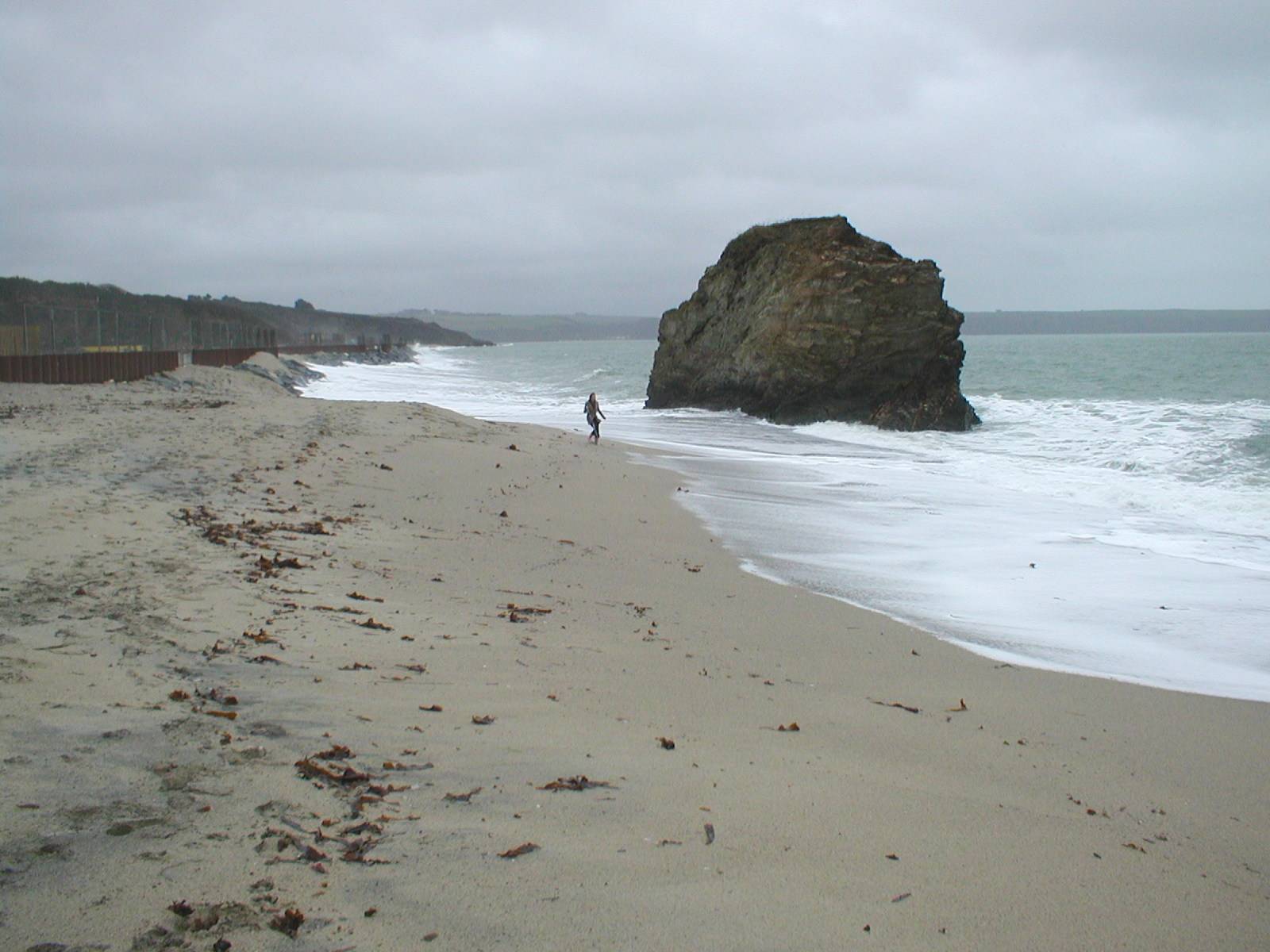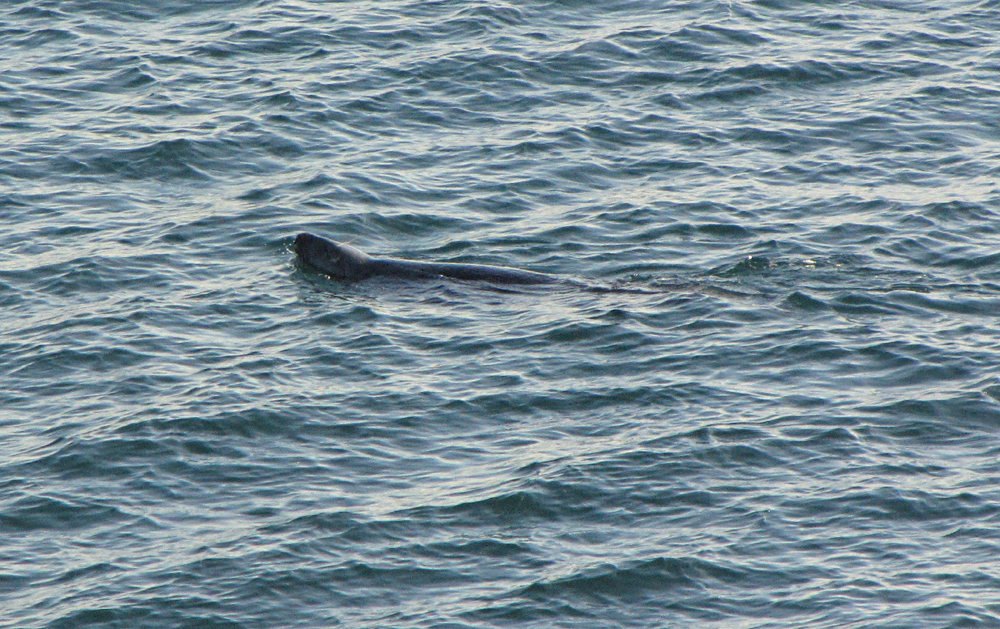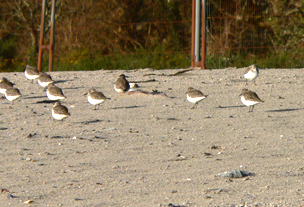





|
|
|
|
|
|

 |
 |
||||||||||||||||
|
|
|||||||||||||||||
|
|
||||||
 |
Crinnis at high tide December 2006 with the shuttering cutting off most of the beach |
Carlyon Bay Watch believes the ecological future of Crinnis, Shorthorn and Polgaver beaches plus St Austell Bay itself has been and can only remain drastically damaged as a result of the proposed development.
The proposal to deliver huge quantities of "stent" onto the beach as part of the sea defence scheme eventually rejected after a Public Inquiry in November 2006 amounted to nothing less than the perpetual dumping of industrial waste into the ocean. It would have been spread and re-spread across the strand, tapering down to a constantly moving shoreline a kilometre at least in length, must cause huge kaolin plumes ("marine snow") to permanently smother marine habitat. And this planned continual pollution was designed to last for more than a hundred years. We don't yet know exactly how the new scheme will be protected from rising sea levels - what has been revealed so far is sketchy. But the developers don't seem prepared to scale down their plans so some sort of large sea defence would inevitably be needed. How they plan to prevent it being washed away, we don't yet know. But anything on this development's scale can only be detrimental to the local environment.
LATEST SIGHTING - A SEAL OFF POLGAVER
 |
|
Seal off Fishing Point January 2010 |
As if to lend weight to the fascinating marine life in St Austell Bay, a seal was spotted off the Carlyon Bay beaches by a local resident. The seal was seen swimming off Fishing Point on 8th January 2010 - presumably drawn near the shore by the prospect of food. Mackerel and sea bass are caught in the bay by locals both from the rocks and from boats.
|
Portuguese Man of War |
Also a rare jelly fish was found washed up on the foreshore at Polgaver beach near Fishing Point. Local resident Gloria Price (who kindly sent us this photo) found the Portuguese Man of War on 10th September 2008 when she went to Carlyon Bay to go snorkelling and sent her photos to the Cornwall Wildlife Trust. Its Marine Conservation Officer, Tom Hardy, confirmed it was indeed a Man of War. He warned that the animals can cause very painful stings and even allergic reactions - in some cases it can be fatal. But he says this type of jelly fish is "very rare" in Cornwall and a wetsuit would provide protection. He warned anyone finding one on the beach "not to touch them without gloves" as they can still sting when washed up. He has asked anyone who makes any more sightings of a Man of War to take photographs and let the Cornwall Wildlife Trust know. (How to contact the Cornwall Wildlife Trust)
EELGRASS BEDS
Eelgrass beds are of National Importance and are a UK Biodiversity Action Plan habitat. In the Environmental Impact Assessment relating to the proposed sea wall the developers say no eelgrass beds have been found in Carlyon Bay and "any loss of these habitats are considered to be highly unlikely". Significantly, they go on to claim that eelgrass located further out in the bay could "only be affected if there were increased sediment loads that resulted in smothering...the washing of the beach material will reduce the level of sediments that may be released and so the likelihood of an impact on eelgrass ... is considered to be remote".
But this is contradicted by experts at Cornwall Wildlife Trust who say: "Eelgrass beds are of National Importance and are a UK Biodiversity Action Plan habitat.. ... Contrary to what it says in the EIA, eelgrass beds have been located in the St Austell Bay area. These could be affected by a localised increase in suspended sediment load and through sedimentation material onto the sea bed. Even if this is just short-term, it may have negative impact. Sand with low fines content will help but not prevent all potential problems." (Cornwall Wildlife Trust quoted in Carlyon Bay Watch’s Case for Public Inquiry).
This was reinforced in a survey conducted through the Cornwall Wildlife Trust for the Environment Agency. "Seasearch Surveys in 2004 identified substantial numbers of small patches of eelgrass off Porthpean beach in the St Austell Bay. This is a possible source of eelgrass seen washed up on Par and Carlyon beaches, although it is very likely that there are other beds in the area yet to be found and recorded. The areas off both Carlyon and Par beaches are thought to have similar suitable substrate and shallow conditions where eelgrass should be able to grow successfully. There is potential pressure on these sites through ‘The Beach’ development at Carlyon Bay. ... Zostera marina is very sensitive to human-induced changes, particularly eutrophication, sedimentation, turbidity, water pollution and physical disturbance (Holt et al., 1997). Land claim and adjacent coastal development through the construction of sea defences may cause changes in the hydrological regime which could affect plant growth.... Increased turbidity due to coastal development, dredging, and activities which increase the amount of suspended sediment in the water, can also have negative impacts on eelgrass by reducing light penetration and affecting photosynthesis within the plants. The construction of the sea wall at Carlyon beach could affect the hydrology in the area and in this way impact on any eelgrass beds in the vicinity of the development. Proposed developments at Carlyon beach could potentially impact any eelgrass beds in the bay." (Eelgrass Bed Survey Report - St Austell bay & Mounts Bay - Cornwall 2005)
MARINE SNOW
Oceanographer Dr Michael Fennessy, who was engaged by Carlyon Bay Watch to advise on aspects of the sea wall and beach replenishment, believes if 200,000 tonnes of recharge material - 'stent' or clay waste - were placed in the active tidal zone this would damage life on the sea bed. He states: "The most important aspect of clay pollution is that the fine clay particles which are released slowly into the sea are going to flocculate to form low density aggregates, or flocs. This is the nature of fine suspended particles. Flocs in sea water are referred to as marine snow. ... The introduction of an industrial pollutant to Carlyon Bay cannot be treated simplistically. It will have short-term consequences for water colour but much longer-term consequences for benthic (sea bed) contamination."
A local man, born and raised in St Austell and fishing in the Bay for 40 years, thinks this impact is already under way. Rodney Sprague makes his living providing sand eels to major retail outlets. "The inshore waters of Carlyon Bay are known to be the best in the county for the catching of sand eels. …In my considered view, the kaolin and mica migrating from the shoreline since the construction of the sea wall, and the waves acting upon it for nearly a mile of foreshore, dispersing these materials onto the eel grass and smothering it, will in time destroy the natural habitat of the sand eel. The creation of the large new sand banks has already started this process and the damage will be considerably worsened with the proposed importation of 250,000 tonnes of china clay waste, which I am told, will require regular replenishment. The eel grass is a vital part of the ocean food chain. Along with the sand eels, many other species are regularly found in this area, such as small cuttle fish, bass, mullet, weaver fish, small shore crabs, mackerel and spider crabs. The marine habitat of these creatures is now under threat and likewise, many small businesses such as my own." (Statement of Rodney Sprague of Bethel, St Austell)
"I have seine-netted from Carlyon Bay, namely Crinnis, Shorthorn and Polgaver beaches, and I have been doing this for over 30 years. My catch is sand eels, for which I am properly licensed. I can … confirm that since the construction of the sea wall shuttering, the mussel beds and cockle beds have been completely destroyed. This year it has been particularly noticeable that the sand eel catch has seriously diminished, whereas previously this stretch of coastline was known to be far and away the best sand eel location in Cornwall." (Statement of Richard Crowle of Roche)
 The impact on the terrestrial habitat and species is no less of concern. As local people have already stated, sand from Carlyon Bay migrates to Par as part of the natural processes but the addition of hundreds of thousands of tonnes of china clay waste dumped on the beach at Carlyon Bay could change the nature of the adjacent bay at Par.
The impact on the terrestrial habitat and species is no less of concern. As local people have already stated, sand from Carlyon Bay migrates to Par as part of the natural processes but the addition of hundreds of thousands of tonnes of china clay waste dumped on the beach at Carlyon Bay could change the nature of the adjacent bay at Par.
"Peregrine Falcons nest between Charlestown and Carlyon Bay. Par Beach sand dunes are an SSSI and a local nature reserve. Eighteen species of butterfly breed, including dingy skippers. It’s one of only two known sites of mossy stone crop in the South West. The area has a high botanical interest, also the blue-tailed damsel breeds there. ... Thousands of gulls assemble on the beach at Par before moving to their breeding grounds. Wintertime we have Sanderling, Turnstone, Purple Sandpiper, Red Throated Divers, Great Northern Divers, Black Throated Divers, Common Scoter, Eider Ducks, Slavonian and Red-necked Grebes. Autumn and Spring brings Ringed Plover, Dunlin, Grey Plover, rare Curlew Sandpiper, Little Stint, Wood and Green Sandpiper, Spotted Redshank, Little Ringed Plover, very rare Kentish Plover, Whimbrel, different Terns and also the common and resident birds are here. Kestrels breed on the cliffs at Carlyon Bay. In the middle of the beach at Carlyon Bay was a huge colony of clams - I don’t know if they are still there or not. Marine Life, fish and dolphins that visit the area are all at risk. Cockles and mussels all over at Par Docks, and any change in the tides and water condition could affect all this." (Unsolicited letter from James Brown of St Stephen).
For general enquiries email Carlyonbaywatch@aol.com
